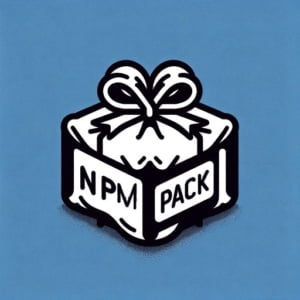NPM Pack | Test, Build, and Publish Your Node.js Package

Packaging a Node.js project is crucial for distributing it efficiently, especially when developing software for use at IOFLOOD. Through our experience, we’ve learned that ‘npm pack’ simplifies the packaging process and ensures that all needed files are included in the distribution. As we believe that our processes can assist our customers developing on our bare metal cloud ecosystem, we’ve put together this comprehensive tutorial on packaing Node.js projects with npm.
This guide will walk you through the npm pack command, showing you how to efficiently package your Node.js projects. From the basics of creating a .tgz file to exploring advanced packaging techniques, we’ll cover everything you need to know to master npm pack.
Let’s dive in and unlock the full potential of npm pack for your Node.js projects.
TL;DR: How Do I Package My Node.js Project Using npm?
To package your Node.js project using npm, simply run the
npm packcommand in your project’s root directory. This command bundles all your project files into a .tgz file, making it easier to distribute or deploy your application.
Here’s a quick example:
npm pack
# Output:
# your-project-name-1.0.0.tgz
In this example, executing npm pack in your terminal generates a .tgz file named after your project and version number. This file contains all the necessary components of your project, neatly packaged for distribution or deployment.
Curious to learn more about npm pack and how to leverage its full potential? Keep reading to discover advanced packaging techniques and best practices for Node.js developers.
Table of Contents
Packaging Basics: npm pack
When you’re ready to take the first step towards distributing your Node.js project, npm pack is your go-to command. It’s straightforward, yet powerful, allowing you to bundle your project into a single .tgz file. This section will guide you through your first packaging experience, highlighting both its simplicity and its limitations.
Your First npm pack Command
Let’s start by packaging a simple Node.js project. Ensure you’re in your project’s root directory, then run the following command:
npm pack
# Output:
# package-name-0.0.1.tgz
In this example, after executing npm pack, you’ll find a new file in your directory named package-name-0.0.1.tgz. This file is a tarball, a compressed archive, containing your project’s files. The naming convention reflects your project’s name and version, as specified in your package.json file.
Understanding the Output
The generated .tgz file is more than just a compressed version of your project. It’s a snapshot of your application at that moment, ready to be shared or deployed. However, it’s important to note that npm pack includes only files that are part of the npm registry; it might exclude other files you expect to be packaged. This behavior underscores the importance of understanding what gets included and what doesn’t, a crucial consideration for effective project distribution.
Pros and Cons
Pros:
– Easy Distribution: With a single command, you’ve prepared your project for sharing or deployment.
– Simplicity: It’s an accessible starting point for beginners looking to package their Node.js projects.
Cons:
– Limited Control: You might find that not all files you expected are included in the .tgz file. This limitation can be addressed with more advanced packaging techniques, which we’ll explore later.
npm pack serves as a foundational tool in your Node.js project packaging journey. While its ease of use is a significant advantage, understanding its limitations will prepare you for more complex packaging needs.
Advanced npm pack Techniques
As you become more familiar with npm pack, you’ll discover that it offers more than just a basic packaging solution. This section delves into the advanced features of npm pack, specifically focusing on how to fine-tune what gets included in your package. By leveraging the files field in your package.json or utilizing an .npmignore file, you gain greater control over the contents of your package.
Specifying Files to Include
One way to control what gets packed is by specifying entries in the files field of your package.json. This field allows you to explicitly list the files or directories you want to include in your package.
Here’s an example of how to set it up:
{
"name": "your-package-name",
"version": "1.0.0",
"files": [
"lib/",
"index.js"
]
}
In this setup, only the lib/ directory and the index.js file will be included in the package. When you run npm pack, npm will create a tarball that includes only these specified items.
Excluding Files with .npmignore
Alternatively, you can use an .npmignore file to exclude specific files or directories from your package. This file works similarly to a .gitignore file, but it specifically targets the files to be ignored by npm pack.
Create an .npmignore file in your project root and add the files or directories you wish to exclude. For example:
node_modules/
test/
With this configuration, npm pack will exclude the node_modules/ and test/ directories from the resulting package.
Pros and Cons
Pros:
– Greater Control: You decide exactly what goes into your package, eliminating unwanted or unnecessary files.
– Customization: Tailor your package to suit the needs of your project or its consumers.
Cons:
– Requires More Configuration: Achieving the desired packaging outcome involves extra setup steps.
By understanding and applying these advanced npm pack features, you can significantly enhance the quality and relevance of your Node.js packages. Whether you’re looking to streamline your package contents or exclude sensitive files, these techniques offer the flexibility needed to meet your packaging objectives.
Exploring Packaging Alternatives
While npm pack is a powerful tool for packaging Node.js projects, there are scenarios where alternative tools might better suit your needs. Tools like Webpack and Parcel offer additional features for more complex projects, such as bundling, minification, and transpilation. Understanding these alternatives can help you make an informed decision on the best tool for your project.
Webpack: A Comprehensive Bundler
Webpack is a static module bundler for modern JavaScript applications. When Webpack processes your application, it internally builds a dependency graph which includes every module your project needs, then packages all those modules into one or more bundles.
Here’s a basic example of using Webpack:
npx webpack --config webpack.config.js
# Output:
# Hash: 9a3d59a9876ecb3b2c34
# Version: webpack 4.44.2
# Time: 800ms
# Built at: 01/01/2021
# Asset Size Chunks Chunk Names
# bundle.js 1.2 MiB 0 [emitted] main
This example demonstrates how Webpack compiles and bundles the project’s assets, resulting in a single bundle.js file. This approach is particularly useful for complex projects that require advanced features like code splitting, lazy loading, or module federation.
Parcel: Zero Configuration Bundler
Parcel is another bundler that prides itself on being a zero-configuration tool. Unlike Webpack, Parcel attempts to work out of the box without the need for a detailed configuration file.
Using Parcel might look like this:
npx parcel build index.html
# Output:
# ✨ Built in 3.56s.
#
# dist/index.html 245 B 1.78s
# dist/index.js 1.23 MB 340ms
This command tells Parcel to bundle the project starting from index.html. Parcel automatically handles dependencies and optimizes the output. The result is a highly efficient, compressed bundle ready for deployment.
Choosing the Right Tool
Benefits of Webpack and Parcel:
– Advanced optimization features.
– Customizable for complex project needs.
– Supports a broad range of plugins and loaders.
Drawbacks:
– May require more setup and configuration (especially Webpack).
– Can introduce complexity to your project’s build process.
Compared to npm pack, these tools offer more than just packaging—they optimize and prepare your code for production. The choice between npm pack, Webpack, and Parcel depends on your project’s complexity, your specific needs, and your willingness to manage configuration details.
In conclusion, while npm pack is ideal for simple packaging needs, exploring tools like Webpack or Parcel can provide additional benefits for more complex applications. Understanding the strengths and limitations of each tool will guide you to the best packaging strategy for your Node.js project.
npm pack: Common Issues and Fixes
Even with its straightforward approach, using npm pack can sometimes lead to unexpected results or issues. This section will address some common problems you might encounter, offering solutions and best practices to ensure your packaging process is as smooth as possible.
Unexpected Files in the Package
One frequent surprise for developers is finding unexpected files included in their .tgz package. This often results from misunderstanding which files npm pack will automatically include or exclude.
To explicitly control what gets packed, you can use the .npmignore file or the files field in package.json. However, if an .npmignore file is not present, npm will use .gitignore rules, which might not always align with your packaging intentions.
Here’s how to ensure only your desired files are included:
echo "node_modules" > .npmignore
echo "test" >> .npmignore
npm pack
# Output:
# package-name-0.0.1.tgz
This example demonstrates creating an .npmignore file that excludes node_modules and test directories. After running npm pack, these folders will not be part of the resulting .tgz file, making your package cleaner and more focused on the necessary files.
Versioning Issues
Another common challenge is dealing with versioning issues when packaging. It’s crucial that the version in your package.json matches your project’s current development stage. Incorrect or outdated version numbers can lead to confusion or conflicts when deploying or sharing your package.
To update your project’s version before packaging, use the npm version command:
npm version patch
npm pack
# Output:
# package-name-0.0.2.tgz
This command increments the patch version of your project according to semantic versioning, ensuring your package version is up-to-date. After running npm pack, the output file reflects the new version, reducing potential versioning issues.
Best Practices for Trouble-Free Packaging
- Review your
.npmignoreandpackage.jsonfiles: Regularly check these files to ensure they accurately reflect the contents you want to include or exclude from your package. Keep your version updated: Use
npm versioncommands to keep your package version aligned with your project’s progress.Test your package: Before publishing or sharing, unpack your .tgz file (
tar -xvzf package-name-0.0.1.tgz) to verify its contents match your expectations.
By addressing these common issues and adhering to best practices, you can make the most of npm pack for efficient and reliable packaging of your Node.js projects.
Understanding npm and Its Ecosystem
To fully grasp the power and utility of npm pack, it’s essential to dive into the fundamentals of npm itself and its pivotal role in the Node.js and JavaScript ecosystems. npm, which stands for Node Package Manager, is the largest software registry in the world. It allows developers to share and borrow packages, manage project dependencies, and publish their own Node.js packages.
The Importance of Package Management
Package management with npm simplifies the process of working with code across different environments, ensuring that a project and its dependencies are installable and runnable with minimal setup. This is crucial for the development lifecycle, from local development to production deployment.
Consider the following command to install a package:
npm install lodash
# Output:
# + [email protected]
# added 1 package from 1 contributor in 0.506s
In this example, npm install lodash adds the lodash library to your project, demonstrating npm’s role in managing dependencies. The output indicates the version of lodash installed and the time taken for the installation. This process ensures that you’re working with a specific version of a library, mitigating the risk of inconsistencies across different environments.
Packages and Modules: The Building Blocks
In the npm ecosystem, a package is a file or directory that is described by a package.json file. A package can be a small utility, a library, or even a large framework. Modules, on the other hand, are JavaScript libraries that you can include in your Node.js project. npm packages can contain one or more modules, making them reusable across different projects.
Understanding the distinction between packages and modules, and how they contribute to the Node.js and JavaScript ecosystems, is fundamental for any developer looking to leverage npm’s capabilities. By mastering these concepts, you can more effectively utilize npm pack and other npm commands to manage and distribute your projects.
In conclusion, npm serves as the backbone for package management in the Node.js and JavaScript worlds. Its comprehensive ecosystem not only facilitates the sharing and distribution of code but also empowers developers to efficiently manage project dependencies. With a solid understanding of npm’s fundamentals, you’re better equipped to harness the full potential of npm pack for your Node.js projects.
Practical Uses of Packaged Files
Once you’ve mastered npm pack and created your .tgz files, the next steps involve publishing your package to the npm registry, deploying to production environments, or sharing your package with others. This section explores these scenarios, providing insights and examples to guide you through the processes.
Publishing to the npm Registry
After packaging your Node.js project, you may wish to share it with the broader developer community by publishing it to the npm registry. This is done using the npm publish command.
Here’s how to publish your packaged project:
npm publish your-project-name-1.0.0.tgz
# Output:
# + [email protected]
This command publishes your .tgz file to the npm registry, making it available for other developers to install via npm install your-project-name. It’s important to ensure your package version is updated and unique to avoid conflicts in the registry.
Deploying to Production
Deploying your packaged Node.js project to a production environment often requires additional steps for optimization and security. However, the .tgz file created by npm pack serves as a solid foundation for deployment, as it contains all necessary project files.
Before deployment, consider running:
npm ci --only=production
This command installs only the dependencies needed for production, omitting any development dependencies. This practice keeps your production environment lean and focused on what’s necessary for your application to run.
Sharing with Others
Sharing your .tgz package with team members or for testing purposes is straightforward. Simply distribute the .tgz file, and the recipient can install it using npm:
npm install /path/to/your-package.tgz
This command installs the package locally, allowing others to use and test your project without publishing it to the npm registry.
Further Resources for npm pack Mastery
To deepen your understanding and explore more about npm pack and related npm functionalities, consider visiting the following resources:
- npm Documentation: The official npm documentation, covering all commands, including
npm packandnpm publish. Node.js Guides: Comprehensive guides on Node.js, offering insights into package management and deployment strategies.
The npm Blog: Updates, tips, and tutorials from the npm team, providing valuable information on package management and npm features.
By exploring these resources, you’ll gain a more comprehensive understanding of npm’s capabilities, allowing you to leverage npm pack and other npm commands more effectively in your projects.
Recap: npm pack for Node.js Projects
In this comprehensive guide, we’ve explored the essentials of using npm pack to bundle Node.js projects into neat packages. This command simplifies the distribution and deployment of projects, making it an indispensable tool in a developer’s arsenal.
We began with the basics, demonstrating how to use npm pack to create a .tgz file containing your project’s files. We then advanced to more sophisticated techniques, such as specifying which files to include or exclude from the package using the files field in package.json or an .npmignore file.
Next, we explored alternative packaging tools like Webpack and Parcel for more complex projects, highlighting the benefits and trade-offs of each approach. This comparison shed light on the diverse ecosystem of packaging options available, empowering you to choose the right tool for your project’s needs.
Throughout our journey, we tackled common issues that might arise when using npm pack, offering solutions and best practices to ensure a smooth packaging process. This troubleshooting guide aimed to minimize obstacles, allowing you to focus on what truly matters: creating and sharing your Node.js projects.
| Tool | Flexibility | Control over Packaging | Complexity |
|---|---|---|---|
| npm pack | Moderate | High | Low |
| Webpack | High | Moderate | High |
| Parcel | High | Low | Moderate |
As we wrap up, remember that mastering npm pack and understanding its alternatives can significantly enhance your development workflow. Whether you’re packaging a simple project for distribution or deploying a complex application, the knowledge you’ve gained here will serve as a solid foundation.
Embrace the power of npm pack and its alternatives to streamline your project packaging. With these tools at your disposal, you’re well-equipped to tackle any Node.js project, no matter its scale or complexity. Happy coding!


